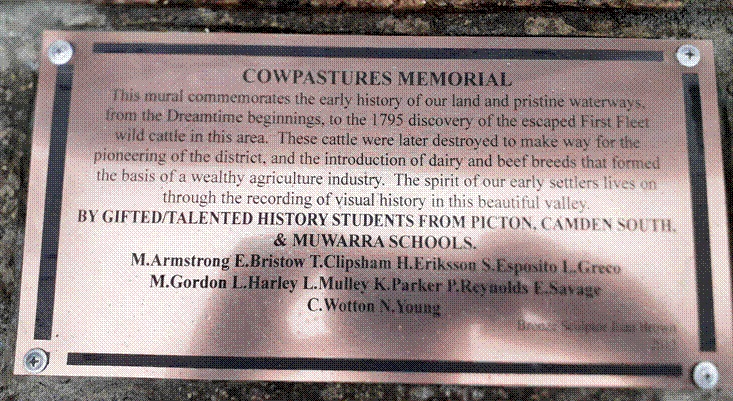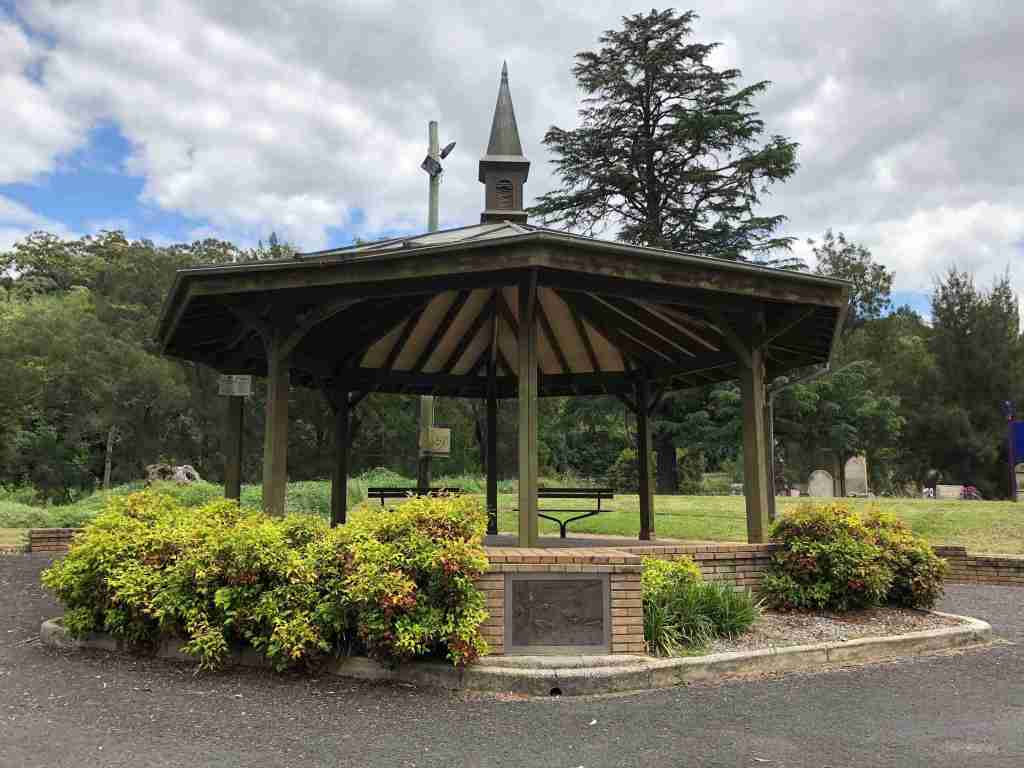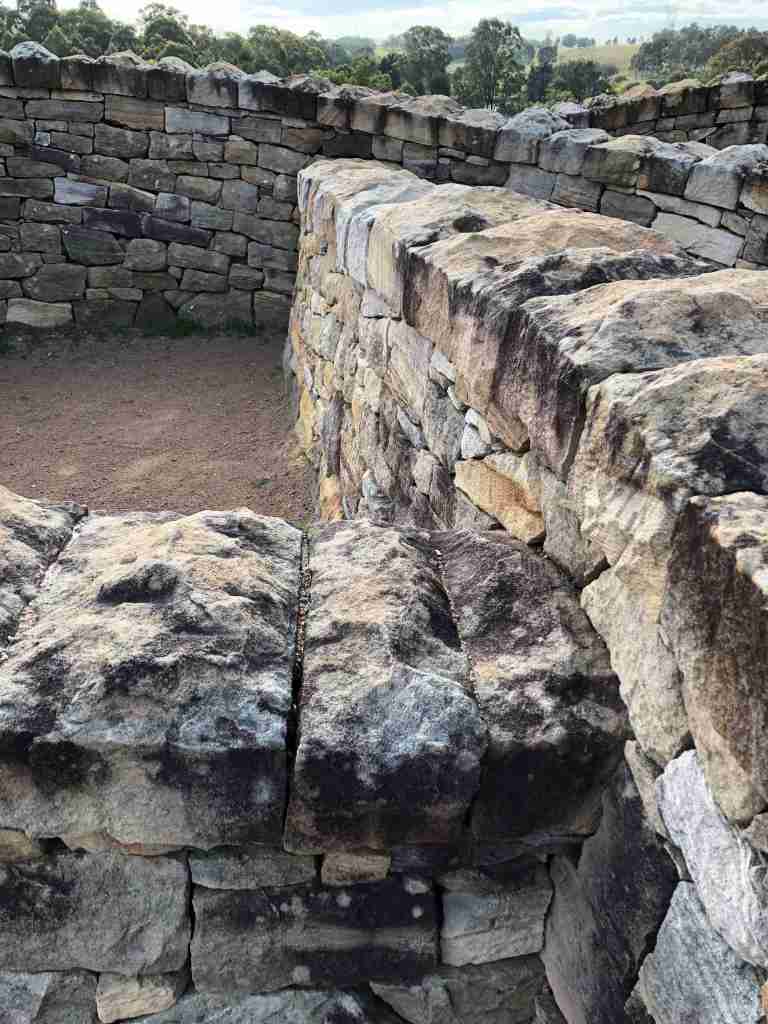The first Cowpasture memorial in the Picton region
The Picton Village Square is the first dedicated memorial in the Picton region to the Cowpastures by local sculptor Joan Brown and local school children. (Council 2019)
The memorial has been placed inconspicuously at the front of the rotunda that is easy to miss as you walk to the shops in Argyle Street from the Davison Lane carpark.
This is only one of three memorials celebrating the Cowpastures in the Macarthur region. The other is located at Perish Park at Oran Park and Harrington Park Lake Reserve.

Information plaque
The information plaque, with the wrong date, has an explanation of the Cowpastures story by the artist and reads:
Cowpastures Memorial
This mural commemorates the early history of our land and pristine waterways, from the Dreamtime beginnings, to the 1895 [sic] discovery of the escaped First Fleet wild cattle in this area. These cattle were later destroyed to make way for the pioneering of the district, the introduction of dairy and beef breeds that formed the basis of a wealthy agricultural industry. The spirit of our early setters lives on through the recording of visual history in this beautiful valley.
By Gifted/Talented History Students from Picton, Camden South, and Mawarra Schools.
M Armstrong, E Bristow, T Clipsham, H Eriksson, S Esposito, L Greco, M Gordon, L Harley, L Mulley, K Parker, P Reynolds, E Savage, C Wotton, N Young.
Bronze Sculptor Joan Brown 2012

Terry O’Toole reports that after representations to Wollondilly Shire Council, the date error on the plaque above was corrected in February 2022. A new plaque has been placed in position, replacing the old one in the photograph above. (Terry O’Toole. Facebook Messenger, 7 March 2022)

Sculptor Joan Brown
Sculptor Joan Brown is a fifth-generation member of a ‘local pioneer family’ growing up on her family property of Abbotsford at Picton. She was surrounded by ‘grazing and dairying properties in the valleys of the Razorback Range’.
Joan is ‘passionate about the preservation of the ethos and heritage of the local area’ and has developed an understanding of the local landscape. She has used local landscapes, historic sites and heritage buildings as subjects of her artworks. (Brown 2021)
Joan was part of the community that initiated the Picton Bicentennial Village Square, where the mural is located, and the restoration of St Mark’s Church and Pioneer Cemetery. (Brown 2021)
Joan has an ongoing passion for the ‘preservation and heritage of the local area’, including the ‘unique heritage village’ of Picton. (Brown 2021)

Public art
The Picton Cowpastures Memorial is one part of the public art scene of the Macarthur region. Other public art installations across the area include:
- the Camden Rotary Pioneer Mural created by mural artist WA Byram Mansell which depicts colonial New South Wales and the Cowpastures
2. the sculpture park on the campus of Western Sydney University at Campbelltown.
3. The statues of local boys celebrating the St Andrews Boys Home at Leppington are located in the gardens at Emerald Hills Shopping Centre and Belltower Park in Emerald Hills Boulevarde.
4. the Australian Botanic Gardens at Mount Annan
5. Art Installation, Oran Park Library, Oran Park.
7. Forecourt, Narellan Library, Narellan
8. Camden Valley Way Forecourt, Food Plaza, Narellan Town Centre.
9. The Cowpasture Cows, Perich Park, Oran Park
11. The Cowpasture Cows, Harrington Park Lake, Harrington Park.

Public art is an essential part of a vibrant community and adds to its cultural, aesthetic and economic vitality. Public art promotes
‘a sense of identity, belonging, attachment, welcoming and openness, and strengthening community identification to place. [It creates] a tangible sense of place and destination’.
The Cowpastures Memorial mural is a visual representation of the dreams and aspirations of its creator.
Principles of public art
Many local government areas have public art. In the Northern Beaches Council LGA, the aims of public art on their coast walks are:
- The need for art to be sympathetic to the natural setting and context.
- A need and opportunity for Aboriginal heritage to be better integrated along the Coast Walk.
- Art was not always seen as physical and permanent with a desire for temporary and activation based experiences that enhanced the Coast Walk.
- Views and vistas are important and they should be preserved or enhanced.
- A desire for the Coast Walk to be an educational experience.
Supporting these aims are eight fundamental principles, and they are:
- Respect and acknowledge Aboriginal cultural heritage
- Celebrate and conserve significant natural and cultural values
- Connect places and people along the coast
- Foster artistic and cultural expression and encourage creative collaboration
- Enrich places through high-quality art and design
- Interpret the history and significance of the coast
- Value artistic and cultural diversity and be inclusive
- Create a distinctive and recognisable Northern Beaches Coast Walk identity.
From The Northern Beaches Coast Walk Public Art.
Cowpastures Mural
A metaphor full of meaning
The Picton Cowpastures Memorial is a metaphor for the settler society and represents the past. The artwork depicts four-horned cows of the Cowpastures Wild Cattle grazing on the steep country around the Razorback Range.
The depiction of the Wild Cattle on Dharawal country hints at the arrival of the colonial frontier in the Cowpastures, the fourth locality of European occupation in the New South Wales colony.(Willis 2018) The horned cattle represent the possession of territory by the Europeans and their settler-colonial project.
The landscape illustrated by the mural is devoid of vegetation, hinting at the environmental desolation caused by European occupation and the dispossession of the Dharawal people. The dead tree depicted in the mural landscape is a sad reminder of European exploitation of the natural resources of the Cowpastures and threats to Cumberland Plain Woodland and other ecological types across the Macarthur region.
The story the mural tells is full of meaning with many layers that can be peeled back to reveal many hidden corners in the narrative of the local area. The stark outline of a dead tree might be regarded as a metaphor for the frontier violence of the early colonial period and symbolic of the Appin Massacre, which took place in the Cowpastures in 1816. (Karskens 2015)
References
Brown, J. (2021). “Joan Brown Biography.” The Sculptors Society. Retrieved 2 November 2021 from https://sculptorssociety.com/sculptors/joan-brown/.
Council, W. S. (2019). Historic Picton Walking Tour. Picton NSW, Wollondilly Shire Council.
Karskens, G. (2015). Appin Massacre. Dictionary of Sydney. Sydney NSW, State Library of New South Wales & City of Sydney.
Willis, I. (2018). “The Cowpastures Project.” Camden History Notes https://camdenhistorynotes.com/2018/03/16/the-cowpastures-project/.
Updated 7 March 2022. Originally posted 4 November 2021.


You must be logged in to post a comment.